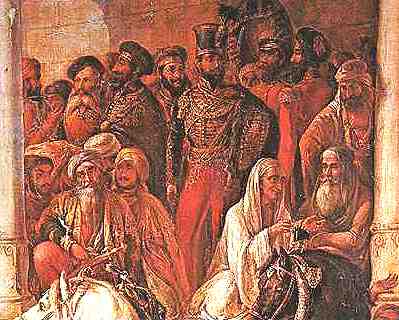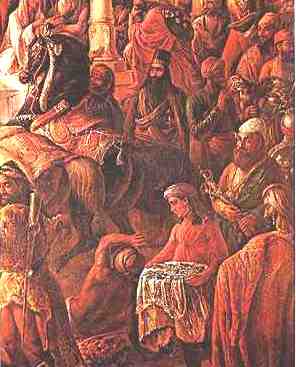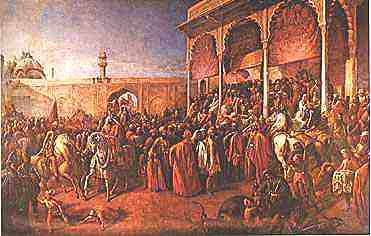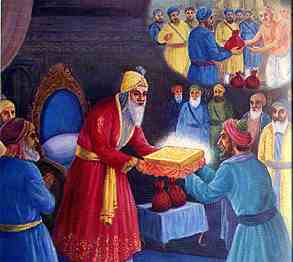Sher-e-Punjab
Maharaja
Ranjit Singh- Page2
There
remains a fourth group to whom he owed some of his success. These were various
European adventurers who were employed as officers after 1822 to organise his
army. Two Italians, Ventura and Avitabile, trained his infantry and also held
civil charges. A Frenchman, Allard, commanded cavalry, while the most efficient
of his troops, the artillery, were trained by a series of Europeans including
the Frenchman, General Court, and the Irish-American Colonel Gardner. Others,
such as Van Cortlandt, were also given commands. Under the leadership of these
Europeans, Ranjit Singh's army became perhaps the most effective force in the
whole of India, the only one to rival the Company's army.
The
foreign army officials in the army of the Maharaja. Allard, Avitabile, Ventura,
Foulks, Steinbach, Cortland. The other local officers are Sham Singh Atariwala
(2nd left), Mehan Singh, Fakir Nuiruddin (extreme right) Fakir Haridas (front
in white).
It
was ultimately, however, from Ranjit's own personality that his power sprang.
Though small and ugly, his charm was irresistible. William Osborne, ADC to the
governor-general, Lord Auckland, met him in 1838, a year before he died, and
his journal, The Court and Camp of Runjeet Singh describes how the Maharaja
im-pressed him: 'the more I see of Runjeet Sing, the more he strikes me as an
extra-ordinary man. Cunning and distrustful himself, he has succeeded in inspiring
his followers with a strong and devoted attachment to his person; with a quick
talent at reading men's minds, he is an equal adept at concealing his own; and
it is curious to see the sort of quiet indifference with which he listens to
the absurd reports of his own motives and actions which are daily poured into
his ears at the Durbar, without giving any opinion of his own, and without rendering
it possible to guess what his final decision on any subject will be, till the
moment for action has arrived.
His humility can be judged by the way he treated the 'Pujarees' of the Delhi
Gurdwara, when they came to visit him at Lahore. He swayed their feet with
his beard in a way of reverence to welcome them. In another incident he surrendered
himself to Akali Phula Singh to be flogged on his back for befriending the
courtesan Moran. The Maharaja never forgot to humour the democratic feeling,
or rather, the theocratic feeling of the Sikhs. He professed to rule "by the
grace of God" like any pious king; the name of the Guru was on his coins,
and he was no more than chosen leader of the people, with whom he was always
popular.
He had a very keen eye for recognising the talents of people, which was
the reason that the most ingenious civil and military personnel always surrounded
him, and advised him on various aspects of the running of the kingdom. He
was very generous and always presented the deserving with "Jageers and Khilats".
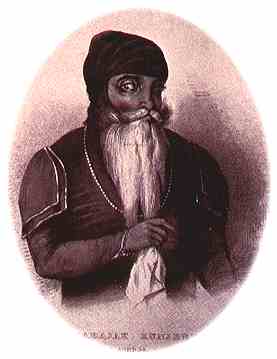
The
Maharaja was very much admired by the surrounding Rajahs and the foreign journalists
who visited Punjab. W. Moorcraft, in his journeys writes, "I have never seen
a more brave and able king in the whole of Asia than Maharaja Ranjit Singh."
The court of Lahore.
Court, Meka Singh, Bhai Gurmukh Singh, Attar
Singh Sindhawalia, Misr Beli Ram, a horse-dealer from Kandahar.
After
creating a united Punjab during his short spell, the Maharaja passed away on
27th June 1839. His tomb is built in front of the Lahore Fort.
A
very rare painting of the Maharaja
The
grandeur of the Lahore Durbar
A
Muslim calligrapher spent the best part of his life preparing a copy of the
Holy Quran. Failing to sell his work to the Muslim chiefs of India, he came
to Lahore. Maharaja Ranjit Singh paid a fabulous price for this work. While
giving donations to religious places he never made any discrimination.
